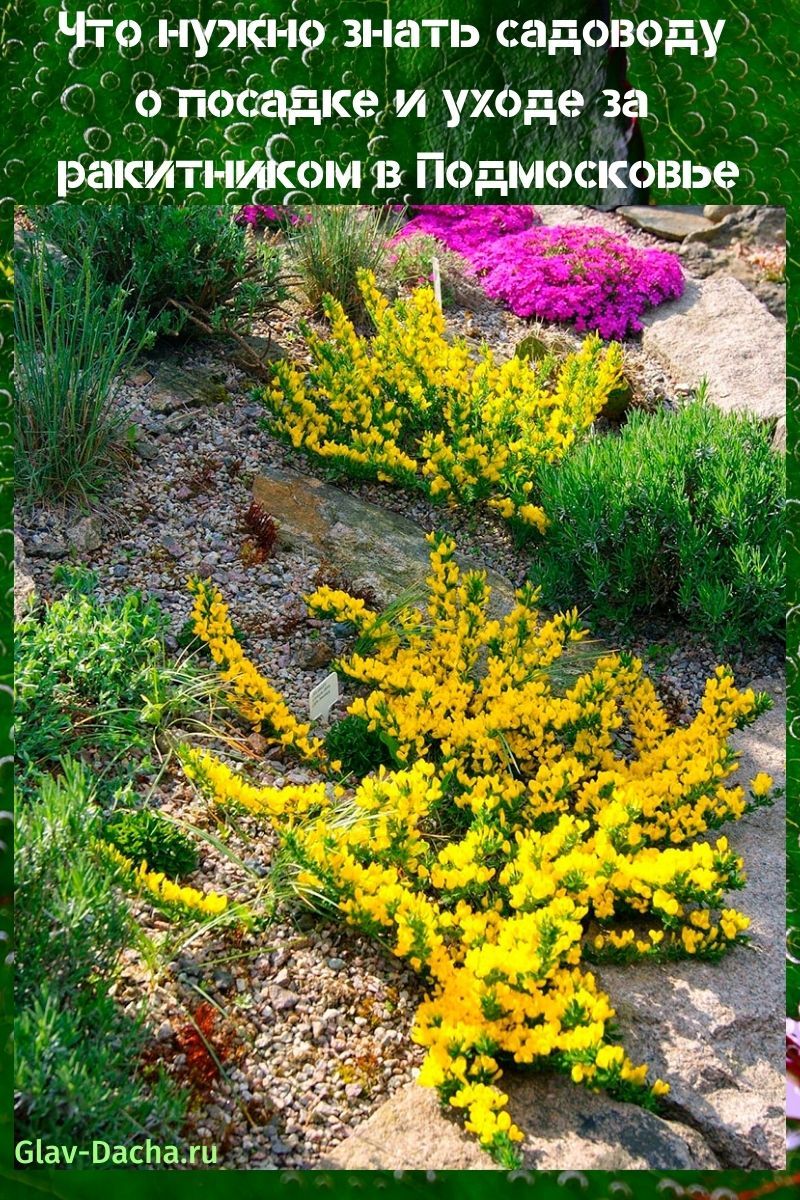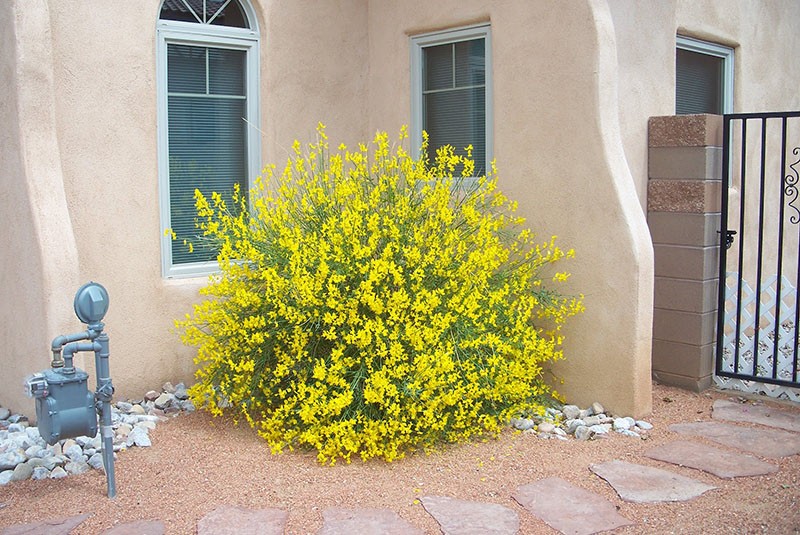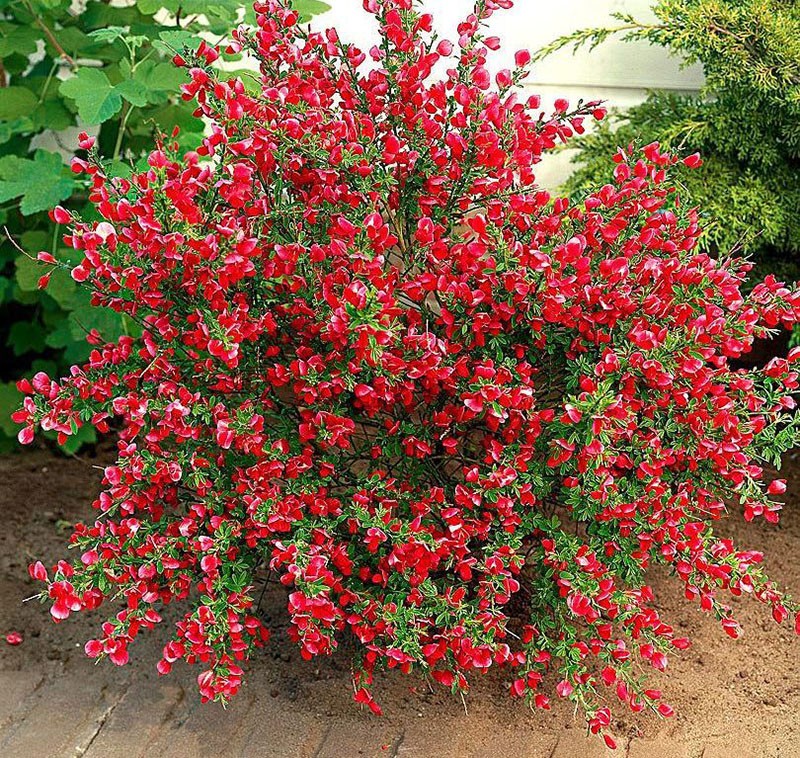What a gardener needs to know about planting and caring for broom in the Moscow region
 Broom is a perennial ornamental shrub that attracts the attention of gardeners with its lush and vibrant flowering. Planting and caring for the broom does not cause any particular difficulties, which ensured the plant wide popularity in landscape design and gardening of garden plots. When growing broom in the Moscow region and other regions of the country, the climatic features of the region must be taken into account. This will allow you to get a lush and abundant flowering of the broom, lasting from early spring to late summer.
Broom is a perennial ornamental shrub that attracts the attention of gardeners with its lush and vibrant flowering. Planting and caring for the broom does not cause any particular difficulties, which ensured the plant wide popularity in landscape design and gardening of garden plots. When growing broom in the Moscow region and other regions of the country, the climatic features of the region must be taken into account. This will allow you to get a lush and abundant flowering of the broom, lasting from early spring to late summer.
The best types of broom for the Moscow region

Planting and caring for broom in the Moscow region requires compliance with several important rules, first of all - the choice of a suitable variety:
- Boskop Ruby is a hybrid species with a dense, spherical crown and inflorescences of a bright purple-ruby color. Reaches 1.7-2 m in height, blooms in late May.

- Andreanus is a tall variety of broom, growing up to 2-2.5 m. It has an unusual red-yellow color of flowers and a pleasant aroma reminiscent of pineapple.

- Albums is one of the best varieties for the Moscow region, as it is characterized by increased frost resistance. This type of broom easily tolerates frosts down to -38 ° C. The shrub reaches 80-100 cm in height, has a dense crown with lush white flowers.

- Purple is one of the most popular low-growing varieties, the height of which usually does not exceed 35-45 cm. The bush is covered with trifoliate leaves and small flowers of a lilac-purple hue.

- Russian - great for growing in the suburbs. Deciduous shrub up to 1.5-1.6 m high, with curving shoots and small, bright yellow flowers.

The winter hardiness of wild broom varieties is not suitable for the Moscow region, such species do not tolerate the harsh weather conditions of this region.
For cultivation in the Moscow region, it is better to choose hybrid varieties that combine decorative attractiveness and high frost resistance.
Planting and caring for broom in the Moscow region
 Broom in the Moscow region is grown from seedlings or seeds. Planting work can be started in early spring. First of all, you need to choose a site for the shrub - it should be well lit, warm and reliably protected from the wind.
Broom in the Moscow region is grown from seedlings or seeds. Planting work can be started in early spring. First of all, you need to choose a site for the shrub - it should be well lit, warm and reliably protected from the wind.
The broom “prefers” sandy loam, well-drained soil with a slightly acidic or neutral reaction. It is also advisable to prepare a soil mixture from sod soil in advance, humus and sand in a 1: 1: 2 ratio - it will be used to fill the planting hole.
Preparation of planting material and site
 When planting and caring for broom, it is very important to properly prepare the planting material. It is best to buy seedlings from a specialized nursery or gardening store. When buying, you need to find out the variety, the age of the seedling, as well as its frost resistance.
When planting and caring for broom, it is very important to properly prepare the planting material. It is best to buy seedlings from a specialized nursery or gardening store. When buying, you need to find out the variety, the age of the seedling, as well as its frost resistance.
 Broom can also be grown from seeds collected by yourself or purchased from stores.Pre-soak the seeds for 48 hours in warm water, then sow in a container with a well-moistened mixture of peat and sand. The sowing depth of seeds should be no more than 1 cm.
Broom can also be grown from seeds collected by yourself or purchased from stores.Pre-soak the seeds for 48 hours in warm water, then sow in a container with a well-moistened mixture of peat and sand. The sowing depth of seeds should be no more than 1 cm.
After that, the container with the seeds should be covered with plastic wrap and placed in a warm, sunny place. When seedlings appear with 3-4 strong, real leaves, the seedlings can be dived and planted in separate containers. They can be transplanted into open ground only after 3 years of age.
The site for planting broom must be prepared in advance, preferably in the fall. It should be dug up, it is advisable to simultaneously apply Kemiru-Universal or another complex mineral fertilizer (100-120 g per 1 sq. M).
 For broom, you need to prepare planting holes - their diameter should be about 20 cm larger than the root system of the bush. At the bottom of the pits, be sure to fill in a drainage layer of fine gravel, expanded clay or pebbles. The height of the drainage layer should be at least 15-20 cm.
For broom, you need to prepare planting holes - their diameter should be about 20 cm larger than the root system of the bush. At the bottom of the pits, be sure to fill in a drainage layer of fine gravel, expanded clay or pebbles. The height of the drainage layer should be at least 15-20 cm.
Step-by-step scheme for planting broom
 When planting broom, you need to take into account the size of the shrub and leave the distance between the planting holes - 50-60 cm for tall plants and at least 30 cm for low varieties.
When planting broom, you need to take into account the size of the shrub and leave the distance between the planting holes - 50-60 cm for tall plants and at least 30 cm for low varieties.
Work stages:
- Pour a drainage layer into the planting holes.
- Pour the prepared soil composition on top of the drainage and make a small tubercle.
- Lower the seedling vertically into the hole and spread its roots.
- Sprinkle with potting soil on top and tamp a little.
- Make sure that the root collar is on the ground line.
After that, water the seedlings well and mulch them.
The mulch layer should be at least 4-6 cm high to help retain moisture in the soil and prevent evaporation.
Broom care rules
 The rules for planting and caring for broom are quite simple and consist of regular watering, dressing, loosening and soil mulching... When growing a shrub in the Moscow region, one should not forget about its shelter from winter frosts.
The rules for planting and caring for broom are quite simple and consist of regular watering, dressing, loosening and soil mulching... When growing a shrub in the Moscow region, one should not forget about its shelter from winter frosts.
The broom loves frequent and abundant watering. Pay close attention to the condition of the soil - as soon as it begins to dry out, moisten the plant. But it must be borne in mind that the broom tolerates excess moisture much worse than its lack. Therefore, in a rainy summer, the amount of watering must be strictly limited or completely abandoned.
After moistening, it is advisable to loosen the soil - this should be done to a depth of 10-13 cm. At the same time, remove the weeds that draw nutrients from the soil and slow down the growth of broom.
For lush and long-lasting flowering, ornamental shrubs require a sufficient amount of nutrients. The first time feeding can be done at the end of May, the second - in July.
For spring fertilization, it is best to use urea (30 g per bucket of water) or other nitrogen-containing fertilizers. In summer, the broom requires potassium and phosphorus, so complex mineral fertilizers will be the best solution. From organic matter it is best to choose wood ash - it stimulates the growth and flowering of the bush.
Pruning
 Broom pruning is carried out only after flowering is completed, since it does not need additional crown formation. During pruning, only individual shoots need to be removed to lateral lignified strong branches.
Broom pruning is carried out only after flowering is completed, since it does not need additional crown formation. During pruning, only individual shoots need to be removed to lateral lignified strong branches.
When pruning broom, it should be borne in mind that its shoots contain cytisine. This toxic substance can cause skin burns; therefore, be sure to wear protective gloves.
Pre-winter preparation
 In the Moscow region, it is recommended to grow only frost-resistant varieties of broom, but they also need to be covered before the onset of winter. Pre-winter shelter is especially important for young bushes, after reaching 3-4 years of age, they tolerate winter frosts well and without additional insulation.
In the Moscow region, it is recommended to grow only frost-resistant varieties of broom, but they also need to be covered before the onset of winter. Pre-winter shelter is especially important for young bushes, after reaching 3-4 years of age, they tolerate winter frosts well and without additional insulation.
For winter shelter, a young broom should be covered with garden soil or peat, then pulled off its shoots and pressed to the surface of the soil.This should be done gradually, over 1-2 weeks, using special staples. Despite the flexibility of the branches, there is a risk of damage to them if they are suddenly pressed to the ground.
Broom is a common shrub that is popular among gardeners for its decorative qualities and unpretentious care. When growing a plant in the suburbs, you need to take into account the climatic features of the region. This will help ensure vigorous growth and long, lush bloom.